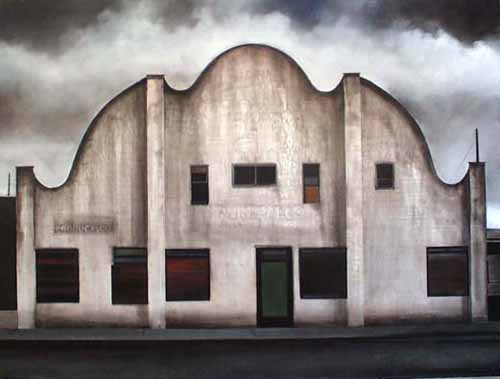Michael Gregory
dal 15/2/2002 al 16/3/2002
Segnalato da
15/2/2002
Michael Gregory
Nancy Hoffman Gallery, New York
Gregory's paintings radiate a contemporary Old Master look, built of manifold layers of oil on wood. Unlike his brilliantly colored still-lifes which preceded and invited the new work, the paintings are quiet of palette, white, black, gray, with a mere suggestion of warmth added by a sepia glow. Once a symbol of progress in American culture, these silos, still standing strong, now regarded as relics, could only be part and parcel of the American horizon and landscape.

Michael Gregory was born in Los
Angeles, California in 1955. He
received a B.F.A. from the San
Francisco Art Institute. He resides
in Bolinas, California.
Gregory's paintings radiate a
contemporary Old Master look, built
of manifold layers of oil on wood.
Unlike his brilliantly colored still-lifes
which preceded and invited the new
work, the paintings are quiet of
palette, white, black, gray, with a
mere suggestion of warmth added by
a sepia glow. Once a symbol of
progress in American culture, these
silos, still standing strong, now
regarded as relics, could only be part
and parcel of the American horizon
and landscape.
Interested in returning to the
landscape, a subject which
occupied the artist's work and
mind for the '80s, Gregory was
inspired by black and white
photographs of wooden buildings
from the '30s with fascinating and
eccentric configurations. Buildings
that seem like fantasy wood
constructions with ziggurat sides
come front and center, pushing the
edges of the frame.
Some of Gregory's structures are
frontal, flat, textured, others are
cylindrical grain elevators weathered
by years of time and use,
cathedral-like in grandeur. As
materials changed in this country
and became richer (from wood to
corrugated metal to tile to concrete)
shapes and structures changed
evolving into simpler, iconic, rounded
forms.
Gregory paints the silos as single
images, dominating a vertical
format. The silos are based on a
composite of photographs taken by
the artist, never a specific building
or place, always Gregory's
invention. Fascinated by the range
of materials of silo structures,
Gregory created tools to paint
these paintings.
While singular paintings, the artist
envisions the silos as a series in a
dialogue of contrasts and
similarities, of nuance, theme and
variation. Gregory contemplated
Monet's signature variations in light
on a cathedral or haystack in
creating these new works, his
turn-of-the-century paintings. Like
his tulips, singular icon images of
the flower set against a black
background, symbols of
impermanence, the silos are symbols
of time and history.
Gregory has been inspired by
masters throughout art history. His
early landscapes of the '80s owed
their debt to George Innes, Martin
Johnson Heade and Albert Pinkham
Ryder, combined with the powerful
pull of the California landscape to
which the artist traveled on a daily
basis between the Sierra foothills
and the Central Valley, a flat
horizon of landscape as far as the
eye can see.
His still lifes which preceded the
silos, are infused with his
appreciation for the Spanish
masters, Zurburan and Sanchez
Cotan. The silos make reference to
the work of Sheeler and Demuth. In
sum, these are American paintings
by an American artist of structures
within which live history, a sense of
time gone by when the pioneering
spirit created shapes of whimsy and
non-conformity.
NANCY HOFFMAN GALLERY
429 WEST BROADWAY (between Prince and Spring)
NEW YORK, 10012
phone (212)966-6676
fax(212)334-5078



